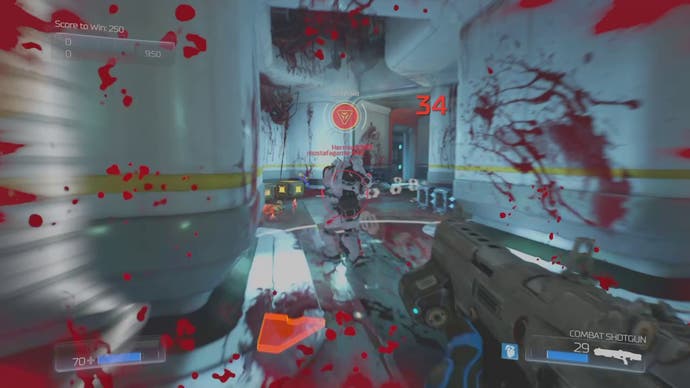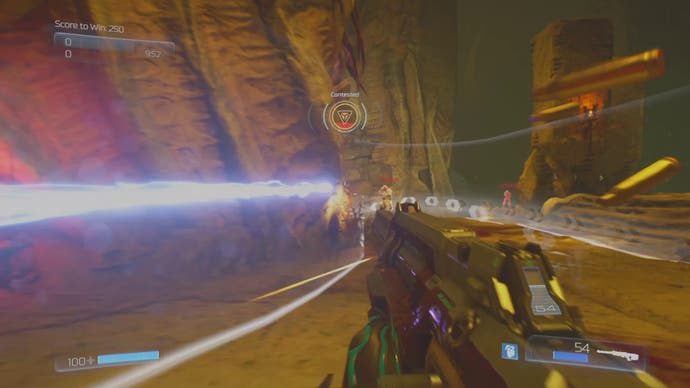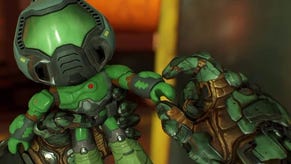In defence of Doom's multiplayer
Squad damage.
Much like Doom's stellar campaign demonstrates the single-player first-person shooter coming full circle while dragging the best of the past 20 years along for its blood-soaked ride, so too does its multiplayer. Here we have a return to online combat as an afterthought; a frozen dessert after a delicious main course as opposed to the kind of life-engulfing commitment online shooters have morphed into in recent times.
In truth, 'afterthought' is unfair. While Doom's online modes can't compare to the raw carnage of its campaign, this small suite of maps and modes unpeels like a demonic onion to reveal ever more layers (or should that be circles) of depth. You'd never know it from the first impression it gives, though.
Yanked out of the meticulously constructed campaign, with its demon-purging crescendos and its gnawing synth-backed periods of uncomfortable disquiet, those who enter the multiplayer suite are presented with clean suits of Halo-style armour, generic game modes like Team Deathmatch and Domination, and for reasons only known to the trigger-happy minds at id, a primary loadout featuring a rocket launcher as a main weapon.
Sometimes the smallest design choices can leave the biggest impacts. By positioning the rocket launcher as the first weapon in the first loadout, Doom directly tells you that this is the place to start - here is your Ryu, here is your AK47. But the rocket launcher isn't the same tube of butchery you've been eviscerating hellspawn with in the campaign. No, this one has almost no splash damage. No three-missile lock on. And certainly no real use in a close-quarters firefight.

And so it takes some time to settle into Doom multiplayer, because it does things a little differently to what we're used to. As you unlock new weapons, it becomes clear that while you have your standard two firearms-and-a-grenade limit, you can actually choose any of the weapons available as your pair. This is practically unheard of, requiring an immense amount of balancing between guns from the developers to weed out the possibility of an overly-dominant duo.
Soon, if you have the patience, you'll find your weapon, and begin to turn your k/d around, little by little. The rapid pace of the campaign is maintained, as is the lack of reloading, so some of the pockets of quiet you'd normally find in a Call of Duty or Battlefield are missing. Likewise, there is no recharging health - escaping a skirmish alive must always lead to a hunt for med and armour pick ups, and players who quickly adapt to this unusual blend of old-fashioned tropes and modern warfare will find their footing much faster.
It's during this adaptation period that Doom begins to show its muscle. The relative paucity of modes, maps and machine guns means this won't be a game that's played for weeks and months, but given the campaign and the untapped potential of Snapmap, that's not really a complaint. It's actually refreshing to dive into a multiplayer shooter without feeling like you need to have a wiki and a YouTube channel in front of you to even figure out how to equip weapons.
The thunderous thud when you connect with an enemy is another triumph. It's long been said that a huge part of Call of Duty's appeal stems from that gloriously moreish triumvirate of bassy thumps when bullets hit polygonal flesh. Doom, perhaps unsurprisingly, ramps up the intensity, bringing chunky number-splatter, sub-woofer bothering thuds and, of course, anatomy-shredding gore to every kill.
So, with speed and satisfaction sewn up, id has carefully crafted just a handful of interesting new modes to tempt you out of the Team Deathmatch funk. The first of these, Warpath, garnered the most attention pre-release, and rightly so. This is a King Of The Hill game where the hill moves around the map on a set track, meaning the battlefield constantly shifts as the two teams scrap for control. If you gain better map knowledge, you can figure out shortcuts to drop down into the hill at key times, or plan assaults around particular choke points in the map.

The quite brilliant Freeze Tag, a mode that borrows ideas from Halo 5's Arena, joins in on the action. It's a best-of-five single-spawn skirmish, but instead of players dying or being 'downed', they're frozen in ice upon death. Team mates can thaw them out just by standing close, meaning they can still fight while reviving, and also help more than one team mate at a time. Quickly, strategies arise where teams will cover the frozen bodies of their enemies and fire on unsuspecting helpers. And because of the nature of the 'thawing' process, the tide can shift multiple times per round.
Again, with more time spent in Doom online, those layers keep on peeling back and smart little design choices reveal themselves like friendly little Cacodemons vying for your affection. You'll have likely seen that you can play as a demon in multiplayer matches, but this true tide-turner is activated by a spawn-in 'rune' which rapidly shifts everyone's attention away from the objective and towards a point on the map. The team that gets the rune will do some serious damage.... unless they lack the required skill, get themselves killed, and the rune respawns on the corpse for the other team to take over.
And here comes another layer. Hack Modules - essentially Titanfall burn cards- can be activated on each spawn, but work on a timer so even after you die you can still continue with your little perk. Now it may be a highlight of the last person you killed, or an XP boost, but there's one hack that lets you see the spawn timers on all the power weapons, pick ups and runes. Drop that at the right time and you can control the battle with knowledge. Coordinate hack use with your team and, yep you guessed it, it's another layer.
With so much smart design, how curious then that Doom defaults you to the rocket launcher. It's almost as if it wants to test both sides of the audience. Those raised on id's 90s shooters will flounder about failing to rocket jump. The COD crew will cry at the extended TTK. And yet all it takes is a bit of perseverance to uncover a complete, albeit modestly sized multiplayer suite that could comfortably keep you occupied throughout the early summer until the big boys return. Sounds like a hell of a plan.









